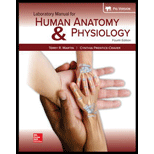
Concept explainers
Lymph finally flows into lymphatic _______ just before connecting to a blood vessel.
a. capillaries
b. collecting ducts
c. vessels
d. trunks
Introduction :
The lymphatic system is a network of organs and tissues that helps rid the body of toxins, waste and other unwanted substances. It is composed of a large group of lymphatic organs, lymphatic or lymphoid tissues, and lymphoid vessels.The major function of the lymphatic system is to carry a fluid containing infection-fighting white blood cells (lymph) all over the body. The additional main function is protection in the immune system.
Answer to Problem 1PL
Correct answer :
The correct answer is option (b) collecting ducts.
Explanation of Solution
Explanation/justification for the correct answer :
Option (b) collecting ducts. A lymphatic duct is a large lymph vessel that releases the lymph into one of the sub clavian veins. There are 2 lymph tubes in the body - right lymphatic duct and thoracic duct. The right lymphatic duct empties from the right upper limb into the lymph, to the right side of the head and neck and the right side of the thoracic. So, this is the correct option.
Explanation for incorrect answer :
Option (a) capillaries. A little blood vessel is called a capillary. They are the smallest blood vessels in the body. They carry blood between arteries and veins. So, this is an incorrect option.
Option (c) vessels. The lymphatic vessel is a thin-walled, streamlined structure that carries the lymph. The blood vessel is a section of the circulatory system and functions to transport blood throughout the body. So, this is an incorrect option.
Option (d) trunks. Apart from the head and limbs, a person's body is called a trunk. Without hands, the part below the neck and above the waist can be considered as a trunk. So, this is an incorrect option.
Lymph finally runs into lymphatic collecting ducts just before connecting to a blood vessel. Hence, the correct answer is option (b) collecting ducts.
Want to see more full solutions like this?
Chapter 49 Solutions
Laboratory Manual For Human Anatomy & Physiology
- Can you described the image? Can you explain the question as well their answer and how to get to an answer to an problem like this?arrow_forwardglg 112 mid unit assignment Identifying melting processesarrow_forwardGive only the mode of inheritance consistent with all three pedigrees and only two reasons that support this, nothing more, (it shouldn't take too long)arrow_forward
- Oarrow_forwardDescribe the principle of homeostasis.arrow_forwardExplain how the hormones of the glands listed below travel around the body to target organs and tissues : Pituitary gland Hypothalamus Thyroid Parathyroid Adrenal Pineal Pancreas(islets of langerhans) Gonads (testes and ovaries) Placentaarrow_forward
- What are the functions of the hormones produced in the glands listed below: Pituitary gland Hypothalamus Thyroid Parathyroid Adrenal Pineal Pancreas(islets of langerhans) Gonads (testes and ovaries) Placentaarrow_forwardDescribe the hormones produced in the glands listed below: Pituitary gland Hypothalamus Thyroid Parathyroid Adrenal Pineal Pancreas(islets of langerhans) Gonads (testes and ovaries) Placentaarrow_forwardPlease help me calculate drug dosage from the following information: Patient weight: 35 pounds, so 15.9 kilograms (got this by dividing 35 pounds by 2.2 kilograms) Drug dose: 0.05mg/kg Drug concentration: 2mg/mLarrow_forward
- A 25-year-old woman presents to the emergency department with a 2-day history of fever, chills, severe headache, and confusion. She recently returned from a trip to sub-Saharan Africa, where she did not take malaria prophylaxis. On examination, she is febrile (39.8°C/103.6°F) and hypotensive. Laboratory studies reveal hemoglobin of 8.0 g/dL, platelet count of 50,000/μL, and evidence of hemoglobinuria. A peripheral blood smear shows ring forms and banana-shaped gametocytes. Which of the following Plasmodium species is most likely responsible for her severe symptoms? A. Plasmodium vivax B. Plasmodium ovale C. Plasmodium malariae D. Plasmodium falciparumarrow_forwardStandard Concentration (caffeine) mg/L Absorbance Reading 10 0.322 20 0.697 40 1.535 60 2.520 80 3.100arrow_forwardPlease draw in the missing answer, thank youarrow_forward
 Medical Terminology for Health Professions, Spira...Health & NutritionISBN:9781305634350Author:Ann Ehrlich, Carol L. Schroeder, Laura Ehrlich, Katrina A. SchroederPublisher:Cengage Learning
Medical Terminology for Health Professions, Spira...Health & NutritionISBN:9781305634350Author:Ann Ehrlich, Carol L. Schroeder, Laura Ehrlich, Katrina A. SchroederPublisher:Cengage Learning Biology (MindTap Course List)BiologyISBN:9781337392938Author:Eldra Solomon, Charles Martin, Diana W. Martin, Linda R. BergPublisher:Cengage Learning
Biology (MindTap Course List)BiologyISBN:9781337392938Author:Eldra Solomon, Charles Martin, Diana W. Martin, Linda R. BergPublisher:Cengage Learning Human Biology (MindTap Course List)BiologyISBN:9781305112100Author:Cecie Starr, Beverly McMillanPublisher:Cengage Learning
Human Biology (MindTap Course List)BiologyISBN:9781305112100Author:Cecie Starr, Beverly McMillanPublisher:Cengage Learning





